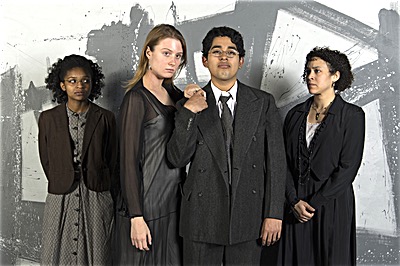- By Matthew Prentice Morgan
- Entertainment
 Print
Print  Jim can feel the eyes of his classmates. He stays up nights reading his law books. He knows the information. None of that matters now. What matters is he's the only black man in a classroom of white eyes and it consumes him. He feels branded.
Jim can feel the eyes of his classmates. He stays up nights reading his law books. He knows the information. None of that matters now. What matters is he's the only black man in a classroom of white eyes and it consumes him. He feels branded.He starts to talk. His voice trembles. He stutters. His mind goes blank. He fails, again. He can't exactly explain why.
Irving Torres '18 knows what Jim, the African American protagonist in Eugene O'Neill's 1924 play All God's Chillun Got Wings was going through. Torres, who plays Jim in the Cornell University Department of Performing and Media Arts and Civic Ensemble production (April 29-May 7), is a first-generation Latino and has been in classes where he's felt those eyes.
"I don't speak up. I don't voice my opinion because to some degree, not to Jim's extent obviously, I feel like I have to be the spokesperson for Latino people. I have to be the spokesperson for first-generation people," Torres says. "I can never just be me."
Though written nearly a century ago, All God's Chillun Got Wings, a play about an interracial couple living in 1920s New York City, is relevant to the students acting in it today, touching on everything from the implicit judgment Torres describes to respectability politics to the roots of BlackLivesMatter vs. AllLivesMatter.
"It is so bold," Torres says. "I viewed the play very much as the internal dialogue in a person of color. This back and forth of self hatred as the result of societal pressures and wanting to overcome them and be free and be worthy and prove themselves worthy."
While All God's Chillun Got Wings is, in essence, a boy meets girl story, the lessons are not simple or easy. The subtext is dense and the issues addressed are difficult, often unpleasant. All God's Chillun Got Wings speaks to the impact of racism not in white hoods or burning crosses but the unspoken societal pressure that can ruin lives and relationships and drive sane people crazy.

All God's Chillun Got Wings is seldom produced but director Godfrey L. Simmons, Jr. resurrected the play years ago in a New York City production partially because, as a black man who was married to a white woman, he identified with the pressures these couples face.
"The big thing with Jim and Ella in this play is the isolation," Simmons, Jr. says. "It's that you feel alone."
Adding to the provocative nature of the Schwartz Center production is the seating arrangement, which will ask people of color to sit on one side of Kiplinger theatre and white people the other.
In his New York City production, Simmons, Jr. used this arrangement to represent the de facto segregation of Jim and Ella's neighborhood. It also forces the audience to consider how other races interpret the play.
"All of a sudden you're like, 'I am watching this play and I am watching these black people watch this play and vice versa,'" Simmons says.
Dominique Thorne '19, who plays Jim's sister Hattie, says the seating arrangement and play are meant to challenge and provoke.
"I feel like some people can walk away enlightened and inspired, or just angry," Thorne says.
Torres added the post-show discussion with the audience will be valuable, perhaps as much as the play itself.
"We want to see their reaction," Torres says. "Usually in theatre, there's a give and take with the audience, but there's never an explicit conversation unless it's deliberate. This time it's a deliberate conversation."
v12i16



